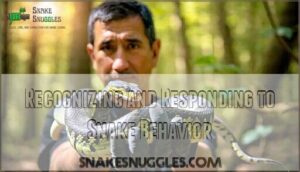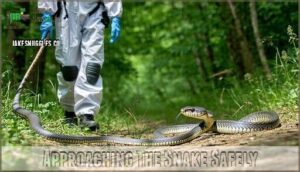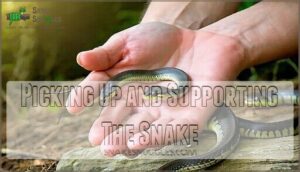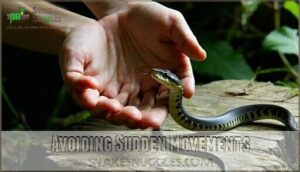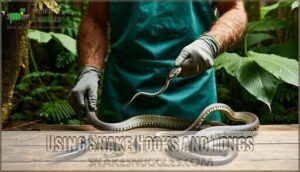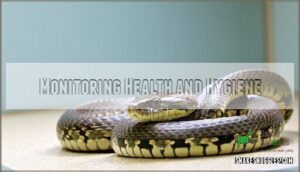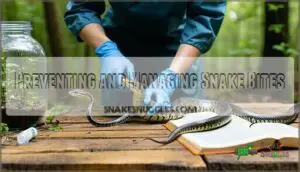This site is supported by our readers. We may earn a commission, at no cost to you, if you purchase through links.
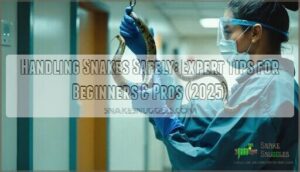
Start by securing your environment – remove breakables, close doors, and clear pathways.
Use appropriate tools like snake hooks for larger species and tongs for confined spaces.
Wear puncture-resistant gloves and protective clothing.
Always sanitize equipment between uses to prevent cross-contamination.
Watch for defensive signals like coiling or hissing before approaching.
Support the snake’s body properly when lifting, avoiding sudden movements.
For venomous species, maintain safe distances and have emergency protocols ready.
Remember that most snakes bite defensively, not aggressively.
The key lies in reading their body language and respecting their space.
This approach helps in handling snakes safely and prevents unnecessary defensive bites.
Table Of Contents
- Key Takeaways
- Preparing for Safe Snake Handling
- Recognizing and Responding to Snake Behavior
- Step-by-Step Snake Handling Techniques
- Essential Snake Care and Feeding Tips
- Preventing and Managing Snake Bites
- Frequently Asked Questions (FAQs)
- Do snakes like being handled?
- What does the Bible say about handling snakes?
- Is there a proper way to hold a snake?
- How to handle the snake?
- What are the dietary requirements for pet snakes?
- Can non-venomous snakes interbreed with venomous ones?
- How can I identify a snake’s species accurately?
- What precautions should I take when housing multiple snakes?
- Are there legal regulations for keeping snakes as pets?
- How often should I handle my snake?
- Conclusion
Key Takeaways
- Prepare your environment and gear first – Clear breakables, secure doors, wear puncture-resistant gloves and protective clothing, and sanitize all tools between uses to prevent contamination.
- Read the snake’s body language before approaching – Watch for defensive signals like coiling, hissing, or striking postures, and only handle the snake when it appears calm and relaxed.
- Use proper handling techniques – Support the snake’s body at the middle third, move slowly and deliberately, and use appropriate tools like hooks for larger species or tongs for confined spaces.
- Know emergency protocols for bites – Clean non-venomous bites immediately with soap and water, but call emergency services instantly for venomous bites, while keeping the limb below heart level.
Preparing for Safe Snake Handling
Before you handle any snake, you’ll need to prepare your environment and gather the right tools to safeguard everyone’s safety.
This preparation phase is vital because snakes can sense stress and sudden movements, making proper setup the difference between a smooth interaction and a potentially dangerous situation.
Creating a Safe Environment
Before establishing your snake’s home, clear the area of potential dangers. Your snake care routine starts with proper Environmental Control and Hazard Communication to guarantee Family Safety around the snake cage.
- Remove breakable objects from handling areas
- Secure loose cables or decorative items
- Close doors to prevent escapes
- Clear pathways for safe movement
- Establish Isolation Protocols for the snakes habitat
Choosing The Right Equipment
Beyond basic handling, your snake handling kit needs specific components.
Snake hooks with wide U-shaped ends work best for lifting larger species. Tong length should match your environment—shorter for tanks, longer for open areas.
HexArmor handling gloves resist punctures from non-venomous species. Transport carriers need secure lids and ventilation.
Quality hook materials and proper enclosure security prevent dangerous escapes during handling sessions. It’s also important to keep in mind snake handling gloves for added protection.
For inexperienced handlers, a 1.5 meter tong is recommended.
Sanitizing Hands and Tools
After choosing your equipment, proper sanitization becomes your first line of defense against bacterial transmission.
Wash your hands thoroughly before and after handling snakes. Clean tools prevent cross-contamination between different animals in your collection.
Snake Handling Kit Sanitization Steps:
- Tool sterilization – Soak hooks and tongs in antiseptic solutions for 10 minutes between uses
- Surface disinfection – Wipe down work areas with hospital-grade disinfectants
- Glove hygiene – Replace disposable gloves after each snake or wash reusable ones with antibacterial soap
- Preventing cross-contamination – Use separate tools for different species when possible
Wearing Protective Gear
Three essential protective barriers separate you from potential bites.
Safety gloves made from puncture-resistant materials like Kevlar offer hand protection during snake handling.
Leather boots provide ankle coverage against ground-level strikes.
Eye protection shields your face from defensive lunges.
Thick clothing barriers block fangs from reaching skin.
For dusty environments, respirator use prevents inhaling particles while maintaining clear vision and steady breathing.
Understanding proper snake handling safety is vital for minimizing risks when interacting with snakes, and having the right equipment is crucial for ensuring safety.
Recognizing and Responding to Snake Behavior
Understanding snake behavior is essential for safe handling since snakes communicate their comfort level through body language and behavioral cues.
You’ll need to recognize defensive signals like coiling, hissing, or striking postures to avoid dangerous situations and determine the best times for interaction.
Common Myths About Snakes
Snake myths cloud your judgment when handling snakes.
Many beliefs about reptile behavior stem from folklore rather than science.
Understanding wild snake behavior helps you stay safe during encounters.
Common snake legends you shouldn’t believe:
- All snakes are venomous – Only 15% of species possess medically significant venom
- Snakes chase people – They retreat from threats and rarely pursue humans
- Baby snakes are harmless – Juveniles can deliver dangerous bites unpredictably
These reptile misconceptions lead to unnecessary fear.
Most handling accidents occur when people panic based on venom facts they’ve misunderstood.
Identifying Aggressive or Defensive Signals
When you’re handling defensive snakes, watch for these warning signs that signal trouble ahead.
A coiled snake with raised head means business. Flattened necks and open mouths show defensive postures you can’t ignore.
Hissing sounds accompany most threat displays. Tail vibration against objects creates rattling noises even in non-venomous species.
Aggressive snake behavior includes lunging forward or striking motions. These defensive signals help prevent snake bites before they happen, and understanding them is crucial for avoiding snake bites.
Understanding Body Language
Frequently, experienced handlers use posture analysis to decode snake intentions before attempting contact.
A coiled snake with raised head signals readiness to strike, while an S-shaped curve indicates potential flight.
Eye contact varies by species but dilated pupils often show stress.
Tail signs include rapid vibration or elevation during agitation.
Scaled patterns can appear more pronounced when muscles tense.
These behavioral cues help you handle defensive snakes safely by reading their mood first.
Knowing When to Handle Snakes
Once you’ve read your snake’s body language, timing becomes everything.
Avoid handling during the Snake Shedding Cycle when eyes appear milky or skin looks dull. Skip handling sessions after feeding for 48-72 hours to prevent regurgitation.
Young snakes need gentler approaches and shorter sessions. Stressed or defensive snakes require patience.
Schedule Snake Health Checks during calm periods when your snake appears alert but relaxed.
Step-by-Step Snake Handling Techniques
Once you’ve assessed the snake’s behavior and prepared your equipment, you’re ready to begin the actual handling process.
The key to successful snake handling lies in smooth, deliberate movements and proper body support techniques that keep both you and the snake safe, utilizing proper techniques.
Approaching The Snake Safely
Now you’re ready to handle a snake. Move slowly toward your target and maintain safe distance initially.
Watch for defensive signals like coiling or hissing. Keep your movements deliberate and calm. Position yourself at the snake’s side rather than approaching head-on.
Wear protective clothing and have your snake hook ready. This aware positioning prevents startling and reduces stress for both you and the snake.
Understanding proper snake handling safety is essential for a successful and safe encounter.
Picking Up and Supporting The Snake
Grip the snake firmly but gently around its middle third, never the head or tail.
Use both hands to support the whole body as you lift, distributing weight evenly. Your snake grip should feel secure without squeezing.
These handling techniques prevent injury to both you and the snake. Proper support methods guarantee the snake feels stable during lifting.
Avoiding Sudden Movements
Snakes detect vibrations through their bodies, making sudden movements a major trigger for defensive behavior.
A snake’s body is like a living seismograph—every vibration tells a story
Use slow approach techniques and maintain calm movement throughout the entire handling process. Your gentle touch should flow smoothly from one position to another.
Quiet action prevents startling your snake, while soft handling keeps stress levels low for both handler and animal, ensuring a peaceful interaction with calm movement.
Using Snake Hooks and Tongs
Professional snake hook safety begins with proper tool selection. Choose hooks with round edges and appropriate length—36 inches minimum for medium snakes.
When handling snakes, position the hook one-third down the body for balanced support. Tongs offer superior control for venomous species but require gentle pressure to prevent injury.
Always sanitize equipment between uses and inspect for defects before capture techniques. The correct handling technique often relies on understanding snake hook designs and proper snake hooks, which is crucial for safe handling.
Essential Snake Care and Feeding Tips
Proper snake care extends beyond handling technique to encompass feeding schedules and habitat management.
You’ll need to establish consistent routines for feeding, cleaning, and health monitoring to keep your snake healthy and reduce defensive behaviors during handling sessions.
Proper Feeding Techniques
Beyond mastering handling snakes, proper feeding techniques guarantee your snake’s health and safety.
Use frozen-thawed prey to prevent parasite transmission and reduce injury risk. Feed juveniles every 5-7 days, adults every 10-14 days based on species metabolism.
Choose prey no larger than 1.5 times your snake’s mid-body diameter. Heat prey to 37℃ for ideal feeding response.
Use feeding tongs and separate containers to prevent defensive behavior and substrate ingestion. Understanding snake feeding techniques is vital for maintaining a healthy and stress-free environment for your pet snake.
Maintaining a Suitable Habitat
While proper habitat design forms the foundation of successful snake keeping, your attention to detail makes the difference between survival and thriving.
Temperature control requires precise gradients—basking spots at 88-95°F with cooler zones around 75-80°F. Humidity levels depend on species but typically range from 50-70%.
Substrate selection affects both comfort and cleaning ease. Proper lighting systems help regulate natural cycles, reducing defensive instincts when you approach your snakes head.
Effective snake enclosures require careful planning and equipment selection, including proper snake habitats to guarantee the well-being of the animals.
Monitoring Health and Hygiene
Vigilance forms the cornerstone of responsible snake ownership. Regular health checks prevent minor issues from becoming major problems.
You’ll need consistent sanitation methods and cleanliness protocols when you handle snakes.
- Daily visual inspections – Check for mites, retained shed, or unusual behavior
- Weekly weight monitoring – Track feeding response and growth patterns
- Monthly deep cleaning – Sanitize enclosures using reptile-safe disinfectants
- Quarantine new arrivals – Isolate for 90 days before introducing to your collection
Disease prevention starts with washing hands before and after every interaction. Even when you handle a viper or other venomous species, hygiene practices remain non-negotiable.
Handling aggressive snakes requires extra attention to cleanliness protocols since stress weakens immune systems.
Preventing and Managing Snake Bites
Even experienced handlers can get bitten, so knowing prevention strategies and proper response techniques is essential for your safety.
Whether dealing with a harmless pet snake or encountering something more dangerous, quick thinking and proper first aid can make the difference between a minor incident and a serious emergency.
Bite Prevention Strategies
The key to bite risk reduction starts with understanding snake behavior patterns.
Most defensive snakes telegraph their intentions through body language before striking.
Watch for coiled postures, raised heads, and rapid tongue flicking.
Always approach from the side, never directly overhead.
When handling aggressive snakes, use proper tools like hooks or tongs to maintain safe distance.
Wash hands before and after contact to remove foreign scents that might trigger defensive responses.
These safety measures substantially lower venom prevention risks during interactions with venomous snakes.
Effective snake bite prevention measures, such as snake safety protocols, can greatly reduce the risk of encounters gone wrong, ensuring a better understanding of snake behavior and promoting safe interactions.
First Aid for Non-Venomous Bites
Even minor bites from a nonvenomous snake require prompt attention.
Clean the wound immediately with soap and water to prevent infection.
- Wound cleaning: Flush thoroughly with clean water for several minutes
- Apply pressure: Use sterile gauze to control bleeding and reduce swelling
- Monitor bite symptoms: Watch for redness, warmth, or unusual pain patterns
- Update tetanus: Make certain your vaccination is current within ten years
Emergency Response for Venomous Bites
Venomous snake bites require immediate medical response. Call emergency services instantly – don’t attempt venom extraction or handle a viper bite yourself.
Remove jewelry before swelling starts. Keep the bitten limb below heart level and immobilized.
Watch for bite symptoms like difficulty breathing or black urine. Only trained professionals should administer antivenom treatment.
Emergency kits can’t replace proper medical care. It’s vital to learn about snake bite treatment to respond effectively in emergencies and understand the importance of proper medical care.
Legal and Safety Considerations
Most states require Permit Requirements for venomous or exotic species, with fines exceeding $10,000 for violations.
Snake Laws mandate proper enclosures and Handling Regulations for public safety.
Following Safety Protocols with safety gloves reduces liability during handling of a snake encounters.
Defensive Snakes pose additional legal risks without documented training, and Professional Snake Care facilities maintain strict Protective Measures and emergency protocols to minimize Liability Concerns and guarantee compliance.
Frequently Asked Questions (FAQs)
Do snakes like being handled?
Most snakes tolerate rather than enjoy your touch.
They’re naturally solitary creatures who don’t seek affection like mammals do.
You’ll find they handle better with consistent, gentle interaction, but they’re simply enduring the experience rather than loving it.
What does the Bible say about handling snakes?
Mark 16:17-18 mentions believers will "take up serpents" as a sign of faith.
However, the passage’s authenticity is debated, and many theologians argue that testing God through dangerous acts contradicts biblical principles.
Is there a proper way to hold a snake?
Want to avoid getting bitten?
Support the snake’s middle with one hand while gently holding behind its head with the other.
Keep movements slow and steady.
Always approach from the side, never from above, to ensure a safe interaction with the snake, and always be cautious.
How to handle the snake?
Support the snake’s body with both hands when lifting.
Move slowly and confidently. Pick up from the middle third of its body, never the head or tail.
Keep movements smooth and deliberate to avoid startling it.
What are the dietary requirements for pet snakes?
Unlike complicated care requirements you might expect, feeding your pet requires simple attention to species-specific needs.
All snakes are carnivores requiring whole prey like rodents, birds, or insects depending on their particular species.
Can non-venomous snakes interbreed with venomous ones?
You can’t crossbreed non-venomous and venomous snakes from different species. Even closely related species rarely produce viable offspring due to genetic incompatibility. Breeding typically only succeeds within the same species.
How can I identify a snake’s species accurately?
Looking at snake identification requires careful observation of key physical features.
You’ll need to examine head shape, pupil type, scale patterns, body proportions, and coloration.
Triangular heads often indicate venomous species, while round pupils suggest non-venomous ones, which can be a key factor in identification.
What precautions should I take when housing multiple snakes?
House each snake separately to prevent disease transmission, territorial disputes, and cannibalism.
Use secure, ventilated enclosures with species-appropriate temperatures.
Quarantine new additions for 30-90 days before introducing them to your collection area.
Are there legal regulations for keeping snakes as pets?
Like traversing a regulatory maze, you’ll find that over 20 states require permits for venomous species , while federal laws govern interstate transport. Check your state, county, and city regulations before purchasing.
How often should I handle my snake?
Handle your snake once or twice weekly for 10-15 minutes.
Avoid handling during shedding, feeding, or for 48 hours after meals.
Start slowly with new snakes to build trust and reduce stress.
Conclusion
Take wildlife photographer Sarah Chen, who successfully relocated a defensive timber rattlesnake from her backyard using proper techniques she’d learned from herpetology courses.
Success in handling snakes depends on consistent preparation and respect for these remarkable creatures.
You’ll need proper equipment, protective gear, and patience to read snake behavior accurately.
Remember that most bites occur when people rush or ignore warning signs.
With practice, you’ll develop confidence while maintaining the caution these animals deserve.
- https://fr.thefreedictionary.com/fa%c3%a7on
- https://www.africansnakebiteinstitute.com/articles/guide_to_buying_snake_handling_equipment/
- https://petwave.com.au/blogs/our-blog-2/snake-hook-vs-snake-tong-what-is-the-safer-choice-to-grab-a-snake
- http://wildliferemovalusa.com/snaketool.html
- https://www.youtube.com/watch?v=QHTXIGRw4a0

